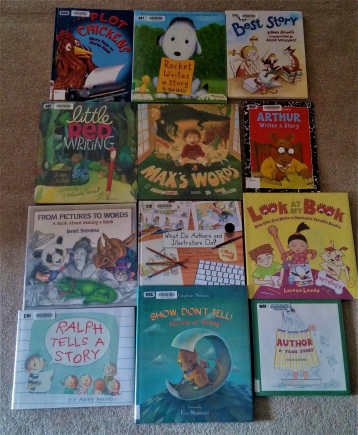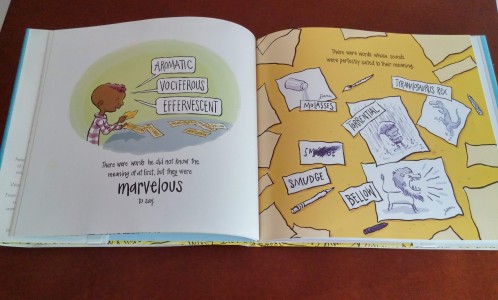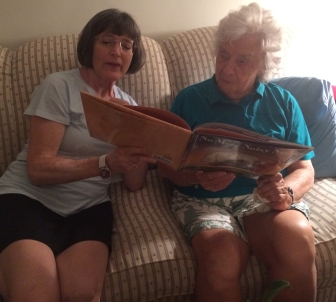Picture books about writing are a great tool for teachers to have in their classroom.

Teachers know that we all have different learning styles. They strive to have materials available for all the learners in their classroom. Sometimes a visit from an outside speaker can spark something new in a student and so I enjoy when I’m invited to a school to talk with students about writing. While my visit may jump start some creative writing, it’s helpful for teachers and students to have other materials to keep the momentum going.
Over the next few posts I’m going to talk about some picture books about writing that would be fun to have available to students of all ages! They are great examples of presenting information creatively. Even middle grade students will be inspired by these books and the pictures help those visual learners.
The publication dates range from 1995-2013, so some are no longer in print, but I did find them all in my local library.
From Pictures to Words: A Book about Making a Book, Janet Stevens, Holiday House, 1995
Synops is: An illustrator shows her process for writing a story. The “characters” she sees in her head interact with her and each other, and help her write the story. These interactions are humorous. She starts with an image, then creates a problem for her characters. As an illustrator, she sees it in pictures first and then writes the words.
is: An illustrator shows her process for writing a story. The “characters” she sees in her head interact with her and each other, and help her write the story. These interactions are humorous. She starts with an image, then creates a problem for her characters. As an illustrator, she sees it in pictures first and then writes the words.
I like:
- Seeing her “ideas” tell her to write a story about them
- That her imagination is in color, but real world in black and white. That helps readers focus on the process.
- That it shows her eliminating characters she likes for the sake of the story
- Seeing the characters explain setting and plot
- That she takes from real life experiences (mountains where she lives, camping she did), but shows how you change that to make a story.
- Seeing her use sketches to figure out beginning, middle and end
- The characters saying its’ boring to show the need for problems and tension.
- How she uses a storyboard to map out story with images and then writes words.
- That it show continued revision as she works with an editor
Arthur Writes a Story: Marc Brown, Little Brown & Co., 1996

Synopsis: Arthur’s assignment is to write a story. His teacher says to write about something important to him, so he writes about getting his dog Pal. But his sister says the story is boring and he should add elephants, so he does. As he shares his story with friends he changes it in the ways they suggest. Eventually his story is nothing like it started. His family thinks it’s confusing. He shares it with the class (by now it is a song and dance story) and they don’t like it. He says it started about his dog. His teacher asks to hear that story. Everyone likes it.
I like:
- That is shows you shouldn’t let others influence you too much
- Showing that story can start from what you know, your life
- The different types of story touched on-humor, mystery, etc
- It’s simplicity for younger students
I didn’t like that it seemed to say that if you are writing about something that really happened, you have to stick to the story. I like to tell students they can take an event or moment and let their imagination help them change it to a creative story. Fiction, of course!
Author: A True story: Helen Lester, Houghton Mifflin 1997
 Synopsis: The author tells the story of writing from when she was small-writing grocery lists (illegible at the age of 3) till now. It shows her struggling as a child to think of ideas, getting stuck in the middle, and the difficulty of making changes teacher wants. She was frustrated! She became a teacher and loves to teach writing because it taps children’s imaginations! After 10 years a friend says she should write a children’s book. The book then talks about how writers work. It shows that hurdles are part of the process.
Synopsis: The author tells the story of writing from when she was small-writing grocery lists (illegible at the age of 3) till now. It shows her struggling as a child to think of ideas, getting stuck in the middle, and the difficulty of making changes teacher wants. She was frustrated! She became a teacher and loves to teach writing because it taps children’s imaginations! After 10 years a friend says she should write a children’s book. The book then talks about how writers work. It shows that hurdles are part of the process.
I like:
- She was a mirror writer and has a good explanation of that
- Shows how it is hard to think of ideas, make changes
- Shows rejection and how, even though she feels bad, she writes again the next day.
- Even though she is an author, she still struggles, gets frustrated, wonders why she does this
- She keeps a box of fizzled thoughts and half-finished books and uses them for new ideas
- Talks about revision and show some
- Talks about writing anytime anywhere-writers are always thinking
- Even though she’s an author, she’s human. She was sad at a book signing because famous authors had more people in line.
 I hear similar stories about I Can’t Stop: A story about Tourette Syndrome. Tourette syndrome is another disorder that is not well understood and often, poorly portrayed in the media. Children with Tourette Syndrome are not intentionally making sounds or movements. When I talk with students about Tourette’s, I ask them if they’ve ever had a mosquito bite. Of course, all the hands go up! Mosquito bites itch. I ask them what happens when they try NOT to scratch it? That’s right, eventually you have to scratch it. That is Tourette’s. Just because a child doesn’t always have tics, doesn’t mean they are doing them intentionally. They have to do them.
I hear similar stories about I Can’t Stop: A story about Tourette Syndrome. Tourette syndrome is another disorder that is not well understood and often, poorly portrayed in the media. Children with Tourette Syndrome are not intentionally making sounds or movements. When I talk with students about Tourette’s, I ask them if they’ve ever had a mosquito bite. Of course, all the hands go up! Mosquito bites itch. I ask them what happens when they try NOT to scratch it? That’s right, eventually you have to scratch it. That is Tourette’s. Just because a child doesn’t always have tics, doesn’t mean they are doing them intentionally. They have to do them.






 is: An illustrator shows her process for writing a story. The “characters” she sees in her head interact with her and each other, and help her write the story. These interactions are humorous. She starts with an image, then creates a problem for her characters. As an illustrator, she sees it in pictures first and then writes the words.
is: An illustrator shows her process for writing a story. The “characters” she sees in her head interact with her and each other, and help her write the story. These interactions are humorous. She starts with an image, then creates a problem for her characters. As an illustrator, she sees it in pictures first and then writes the words.
 Synopsis: The author tells the story of writing from when she was small-writing grocery lists (illegible at the age of 3) till now. It shows her struggling as a child to think of ideas, getting stuck in the middle, and the difficulty of making changes teacher wants. She was frustrated! She became a teacher and loves to teach writing because it taps children’s imaginations! After 10 years a friend says she should write a children’s book. The book then talks about how writers work. It shows that hurdles are part of the process.
Synopsis: The author tells the story of writing from when she was small-writing grocery lists (illegible at the age of 3) till now. It shows her struggling as a child to think of ideas, getting stuck in the middle, and the difficulty of making changes teacher wants. She was frustrated! She became a teacher and loves to teach writing because it taps children’s imaginations! After 10 years a friend says she should write a children’s book. The book then talks about how writers work. It shows that hurdles are part of the process.